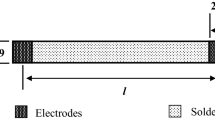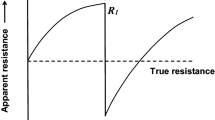Abstract
An electret refers to a permanent electric dipole. Nonconductive electrets (polymers and ceramics) have long been studied and utilized, but conductive electrets (metals and carbons) are emerging. This paper introduces the concept of the electret-based capacitance C′ to elucidate the discharge behavior of conductive electrets in the form of unpoled solder and other conductors (metals). The C′ is defined as the electret charge Q′ (determined by integrating the discharge curve) divided by the DC electret voltage V′. The conventional permittivity-based capacitance C (measured) is lower than C′ by orders of magnitude. For Sn–4Ag lead-free solder, C′ (given by Q′/V′) is 620 F, whereas C is 175 pF. The electret stems from the interaction of a small fraction of the carriers (free electrons) with the atoms, as supported by DC polarization asymmetry. For Sn–4Ag, this fraction is 3.5 × 10–9. Electret discharge (V′ decreasing to zero) occurs upon short circuiting. Self-charge (V′ restored) occurs upon subsequent open circuiting, being slightly more sluggish than discharge. The electret discharge/charge amounts to discharge/charge of C′. The discharge/charge time constant is found to approximately equal RC′ (R = resistance) and the discharge/charge energy is found to approximately equal ½ C′V′2, as expected for the discharge/charge of C′ and shown for Sn–4Ag, copper (0 and 37% cold work) and low-carbon steel. This two-fold agreement between theory and experiment for each of the metals studied strongly supports the C′ concept. Strong correlation occurs among high fraction of carriers that participate, high participating charge density and high discharge time constant.








Similar content being viewed by others
Data availability
Data and material are available by contacting the corresponding author.
Code availability
Codes are not applicable.
Change history
28 November 2022
A Correction to this paper has been published: https://doi.org/10.1007/s10854-022-09385-1
Abbreviations
- C :
-
Capacitance stemming from the permittivity
- C ′ :
-
Capacitance stemming from the electret
- Q :
-
Charge magnitude associated with the capacitance stemming from the permittivity
- Q ′ :
-
Charge magnitude associated with the capacitance stemming from the electret
- V :
-
Voltage applied to cause the charge stemming from the permittivity
- V ′ :
-
Inherent voltage in the electret
- V 1 ′ :
-
Inherent voltage in the electret, obtained without polarity removal
- V 2 ′ :
-
Inherent voltage in the electret, obtained after polarity removal, being opposite in sign from V1′
- J ′ :
-
Current density (current per unit area) in the electret
- J 1 ′ :
-
Current density (current per unit area) in the electret, based on V1′
- J 2 ′ :
-
Current density (current per unit area) in the electret, based on V2′, being opposite in sign from J1′
- E :
-
Electric field applied to cause the charge stemming from the permittivity.
- E ′ :
-
Inherent electric field in the electret
- E 1 ′ :
-
Inherent electric field in the electret, based on V1′
- E 2 ′ :
-
Inherent electric field in the electret, based on V2′, being opposite in sign from E1′
- P :
-
Power density (i.e., power per unit volume) stemming from the permittivity
- P ′ :
-
Power density (i.e., power per unit volume) stemming from the electret
- l :
-
Inter-electrode distance, which is the proximate distance between two electrodes
- A :
-
Cross-sectional area of the specimen in the plane perpendicular to the capacitance, voltage or resistance
- R :
-
Resistance
- ρ :
-
Resistivity
- κ :
-
Relative permittivity
References
D.D.L. Chung, X. Xi, A review of the colossal permittivity of electronic conductors, specifically metals and carbons. Mater. Res. Bull. 148, 111654 (2022)
A.K. Jonscher, Dielectric relaxation in solids. J. Phys. D: Appl. Phys. 32(14), R57–R70 (1999)
X. Xi, D.D.L. Chung, Effect of nickel coating on the stress-dependent electric permittivity, piezoelectricity and piezoresistivity of carbon fiber, with relevance to stress self-sensing. Carbon 145, 401–410 (2019)
X. Xi, D.D.L. Chung, Piezoresistivity and piezoelectricity, dielectricity discovered in solder. J. Mater. Sci.: Mater. Electron. 30(5), 4462–4472 (2019)
X. Xi, D.D.L. Chung, Electret, piezoelectret and piezoresistivity discovered in steels, with application to structural self-sensing and structural self-powering. Smart Mater. Struct. 28(7), 075028 (2019)
H. Guan, D.D.L. Chung, Absorption-dominant radio-wave attenuation loss of metals and graphite. J. Mater. Sci. 56(13), 8037–8047 (2021)
X. Xi, D.D.L. Chung, Role of grain boundaries in the dielectric behavior of graphite. Carbon 173, 1003–1019 (2021)
X. Xi, D.D.L. Chung, Dynamics of the electric polarization and depolarization of graphite. Carbon 172, 83–95 (2021)
W. Yang, D.D.L. Chung, Electric polarization and depolarization of solder, and their effects on electrical conduction. J. Mater. Sci.: Mater. Electron. 32(5), 6214–6227 (2021)
D.D.L. Chung, X. Xi, Electric poling of carbon fiber with and without nickel coating. Carbon 162, 25–35 (2020)
X. Xi, M. Ozturk, D.D.L. Chung, DC electric polarization of cured cement paste being unexpectedly hindered by free water. J. Am. Ceram. Soc. 105(2), 1074–1082 (2022)
D.D.L. Chung, X. Xi, Factors that govern the electric permittivity of carbon materials in the graphite allotrope family. Carbon 184, 245–252 (2021)
X. Xi, D.D.L. Chung, Dielectric behavior of graphite, with assimilation of the AC permittivity, DC polarization and DC electret. Carbon 181, 246–259 (2021)
W. Yang, D.D.L. Chung, Electret behavior discovered in solder, specifically tin-silver. J. Mater. Sci.: Mater. Electron. 32(14), 19145–19156 (2021)
X. Xi, D.D.L. Chung, Electret behavior of unpoled carbon fiber with and without nickel coating. Carbon 159, 122–132 (2020)
X. Xi, D.D.L. Chung, Electret behavior of carbon fiber structural composites with carbon and polymer matrices, and its application in self-sensing and self-powering. Carbon 160, 361–389 (2020)
W. Yang, D.D.L. Chung, Effect of temperature on the electrical conduction and dielectric behavior of solder. J. Mater. Sci.: Mater. Electron. 32(5), 6511–6519 (2021)
H.O. Jacobs, G.M. Whitesides, Submicrometer patterning of charge in thin-film electrets. Science 291(5509), 1763–1766 (2001)
D.P. Erhard, D. Lovera, C. von Salis-Soglio, R. Giesa, V. Altstaedt, H. Schmidt, Recent advances in the improvement of polymer electret films. Adv. Polym. Sci. 228, 155–207 (2010)
P.K.C. Pillai, Polymeric electrets. Plast. Eng. 28, 1–61 (1995)
G.M. Sessler, Electrets: recent developments. J. Electrost. 51–52, 137–145 (2001)
R. Kressmann, G.M. Sessler, P. Guenther, Space-charge electrets. IEEE Trans. Dielectr. Electr. Insul. 3(5), 607–623 (1996)
Y. Liu, Y. Aoyagi, D.D.L. Chung, Development of epoxy-based electrets. J. Mater. Sci. 43(5), 1650–1663 (2008)
C. Huang, D.D.L. Chung, Controlling and increasing the inherent voltage in cement paste. Adv. Cem. Res. 21(1), 31–37 (2009)
M. Lindner, H. Hoislbauer, R. Schwoediauer, S. Bauer-Gogonea, S. Bauer, Charged cellular polymers with ferroelectretic behavior. IEEE Trans. Dielectr. Electr. Insul. 11(2), 255–263 (2004)
I.J. Busch-Vishniac, G.W. Elko, Nearly 40 years of domination by electret microphones. J. Acoust. Soc. Am. 149, R7 (2021). https://doi.org/10.1121/10.0003934
M. Paajanen, J. Lekkala, K. Kirjavainen, ElectroMechanical Film (EMFi)—a new multipurpose electret material. Sensors Actuators 84(1–2), 95–102 (2000)
W. He, W. Xu, H. He, X. Jing, C. Liu, J. Feng, C. Luo, Z. Fan, S. Wu, J. Gao et al., From unipolar, WORM-type to ambipolar, bistable organic electret memory device by controlling minority lateral transport. Adv. Electron. Mater. 6(4), 1901320 (2020)
Y. Zhu, Y. Fan, S. Li, P. Wei, D. Li, B. Liu, D. Cui, Z. Zhang, G. Li, Y. Nie et al., Soluble poly(4-fluorostyrene): a high-performance dielectric electret for organic transistors and memories. Mater. Horizons 7(7), 1861–1871 (2020)
C. Chen, Y. Wang, T. Michinobu, S. Chang, Y. Chiu, C. Ke, G. Liou, Donor-acceptor effect of carbazole-based conjugated polymer electrets on photoresponsive flash organic field-effect transistor memories. ACS Appl. Mater. Interfaces 12(5), 6144–6150 (2020)
Y. Park, K. Baeg, C. Kim, Solution-processed nonvolatile organic transistor memory based on semiconductor blends. ACS Appl. Mater. Interfaces 11(8), 8327–8336 (2019)
C. Shih, Y. Chiang, H. Hsieh, Y. Lin, W. Chen, Multilevel photonic transistor memory devices using conjugated/insulated polymer blend electrets. ACS Appl. Mater. Interfaces 11(45), 42429–42437 (2019)
C. Chen, Y. Wang, H. Tatsumi, T. Michinobu, S. Chang, Y. Chiu, G. Liou, Novel photoinduced recovery of OFET memories based on ambipolar polymer electret for photorecorder application. Adv. Funct. Mater. 29(40), 1902991 (2019)
S. Cheng, Y. Chang Chien, T. Huang, C. Liu, G. Liou, Linkage effects of triphenylamine-based aromatic polymer electrets on electrical memory performance. Polymer 148, 382–389 (2018)
M. Tang, S. Chen, D. Chang, X. Xie, J. Sun, D.Y.H. Pui, Filtration efficiency and loading characteristics of PM2.5 through composite filter media consisting of commercial HVAC electret media and nanofiber layer. Sep. Purif. Technol. 198, 137–145 (2018)
D. Chang, J. Liu, S. Chen, Factors affecting particle depositions on electret filters used in residential HVAC systems and indoor air cleaners. Aerosol Air Qual. Res. 18(12), 3211–3219 (2018)
H. Zhang, J. Liu, X. Zhang, C. Huang, X. Jin, Design of electret polypropylene melt blown air filtration material containing nucleating agent for effective PM2.5 capture. RSC Adv. 8(15), 7932–7941 (2018)
N.S. Sambudi, H. Choi, M. Lee, K. Cho, Capture of ultrafine particles using a film-type electret filter with a unipolar charger. Aerosol Air Qual. Res. 17(2), 626–635 (2017)
A. Kilic, E. Shim, B. Pourdeyhimi, Electrostatic capture efficiency enhancement of polypropylene electret filters with barium titanate. Aerosol Sci. Technol. 49(8), 666–673 (2015)
H. Choi, E. Park, J. Kim, S.H. Kim, M. Lee, Experimental study on charge decay of electret filter due to organic solvent exposure. Aerosol Sci. Technol. 49(10), 977–983 (2015)
A. Kilic, E. Shim, B. Pourdeyhimi, B. Yeom, Aerosol filtration properties of nucleating agent containing electret filters. Polym. Eng. Sci. 54(7), 1533–1539 (2014)
M.A. Parada, A. de Almeida, Teflon electret radiation dosimeter. Nuclear Instrum. Methods Phys. Res. B 191, 820–824 (2002)
R.H. Mahat, D.A. Bradley, Y.M. Amin, C.Y. Wong, L.D. Su, The effect of humidity on the accuracy of measurement of an electret radon dosimeter. Radiat. Phys. Chem. 61(3–6), 489–490 (2001)
X. Xi, D.D.L. Chung, Effects of cold work, stress and temperature on the dielectric behavior of copper. Mater. Chem. Phys. 270, 124793 (2021)
MakeItFrom.com. Hot Rolled 1010 Carbon Steel, https://www.makeitfrom.com/material-properties/Hot-Rolled-1010-Carbon-Steel (Accessed 12 August 2020)
Chung DDL, Duong DQ. Unpublished results
Funding
The authors declare that no funds, grants, or other support were received during the preparation of this manuscript.
Author information
Authors and Affiliations
Contributions
DDLC provided the study conception and design. Material preparation, data collection and analysis were performed by XX. The first draft of the manuscript was written by DDLC and both authors commented on previous versions of the manuscript. Both authors read and approved the final manuscript.
Corresponding author
Ethics declarations
Competing interest
The authors have no relevant financial or non-financial interest to disclose.
Additional information
Publisher's Note
Springer Nature remains neutral with regard to jurisdictional claims in published maps and institutional affiliations.
Rights and permissions
Springer Nature or its licensor (e.g. a society or other partner) holds exclusive rights to this article under a publishing agreement with the author(s) or other rightsholder(s); author self-archiving of the accepted manuscript version of this article is solely governed by the terms of such publishing agreement and applicable law.
About this article
Cite this article
Chung, D.D.L., Xi, X. New concept of electret-based capacitance, as shown for solder and other conductors. J Mater Sci: Mater Electron 33, 27022–27039 (2022). https://doi.org/10.1007/s10854-022-09366-4
Received:
Accepted:
Published:
Issue Date:
DOI: https://doi.org/10.1007/s10854-022-09366-4




